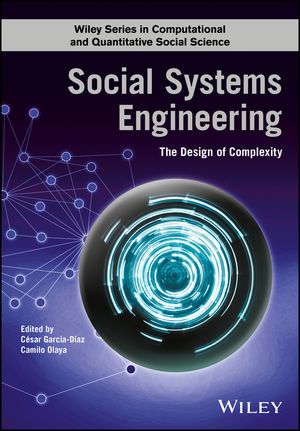
Social Systems Engineering
John Wiley & Sons Inc (Verlag)
9781118974452 (ISBN)
- Titel z.Zt. nicht lieferbar
- Versandkostenfrei
- Auch auf Rechnung
- Artikel merken
Social Systems Engineering: The Design of Complexity brings together a wide variety of application approaches to social systems from an engineering viewpoint. The book defines a social system as any complex system formed by human beings. Focus is given to the importance of systems intervention design for specific and singular settings, the possibilities of engineering thinking and methods, the use of computational models in particular contexts, and the development of portfolios of solutions. Furthermore, this book considers both technical, human and social perspectives, which are crucial to solving complex problems.
Social Systems Engineering: The Design of Complexity provides modelling examples to explore the design aspect of social systems. Various applications are explored in a variety of areas, such as urban systems, health care systems, socio-economic systems, and environmental systems. It covers important topics such as organizational design, modelling and intervention in socio-economic systems, participatory and/or community-based modelling, application of systems engineering tools to social problems, applications of computational behavioral modeling, computational modelling and management of complexity, and more.
Highlights an engineering view to social systems (as opposed to a “scientific” view) that stresses the importance of systems intervention design for specific and singular settings
Divulges works where the design, re-design, and transformation of social systems constitute the main aim, and where joint considerations of both technical and social perspectives are deemed important in solving social problems
Features an array of applied cases that illustrate the application of social systems engineering in different domains
Social Systems Engineering: The Design of Complexity is an excellent text for academics and graduate students in engineering and social science—specifically, economists, political scientists, anthropologists, and management scientists with an interest in finding systematic ways to intervene and improve social systems.
César García-Díaz, PhD, is an Assistant Professor in the Department of Industrial Engineering, Universidad de los Andes, Bogotá, Colombia. César's expertise is in the field of agent-based social simulation. Camilo Olaya, PhD, is an Associate Professor in the Department of Industrial Engineering, Universidad de los Andes, Bogotá, Colombia. Camilo is a researcher in model-based engineering of private and public systems with more than 15 years of experience in this field.
List of Contributors xi
Preface xiii
Introduction: The Why, What and How of Social Systems Engineering 1
César García-Díaz and Camilo Olaya
Part I SOCIAL SYSTEMS ENGINEERING: THE VERY IDEA 11
1 Compromised Exactness and the Rationality of Engineering 13
Steven L. Goldman
1.1 Introduction 13
1.2 The Historical Context 14
1.3 Science and Engineering: Distinctive Rationalities 20
1.4 ‘Compromised Exactness’: Design in Engineering 23
1.5 Engineering Social Systems? 26
References 29
2 Uncertainty in the Design and Maintenance of Social Systems 31
William M. Bulleit
2.1 Introduction 31
2.2 Uncertainties in Simple and Complicated Engineered Systems 33
2.3 Control Volume and Uncertainty 35
2.4 Engineering Analysis and Uncertainty in Complex Systems 37
2.5 Uncertainty in Social Systems Engineering 39
2.6 Conclusions 42
References 42
3 System Farming 45
Bruce Edmonds
3.1 Introduction 45
3.2 Uncertainty, Complexity and Emergence 46
3.2.1 The Double Complexity of CSS 48
3.3 Science and Engineering Approaches 49
3.3.1 The Impossibility of a Purely Design-Based Engineering Approach to CSS 51
3.3.2 Design vs. Adaptation 52
3.3.3 The Necessity of Strongly Validated Foundations for Design-Based Approaches 53
3.4 Responses to CSS Complexity 54
3.4.1 Formal Methods 54
3.4.2 Statistical Approaches 55
3.4.3 Self-adaptive and Adaptive Systems 57
3.4.4 Participatory Approaches and Rapid Prototyping 57
3.5 Towards Farming Systems 58
3.5.1 Reliability from Experience Rather Than Control of Construction 58
3.5.2 Post-Construction Care Rather Than Prior Effort 58
3.5.3 Continual Tinkering Rather Than One-Off Effort 59
3.5.4 Multiple Fallible Mechanisms Rather Than One Reliable Mechanism 59
3.5.5 Monitoring Rather Than Prediction 59
3.5.6 Disaster Aversion Rather Than Optimizing Performance 59
3.5.7 Partial Rather Than Full Understanding 59
3.5.8 Specific Rather Than Abstract Modelling 60
3.5.9 Many Models Rather Than One 60
3.5.10 A Community Rather Than Individual Effort 60
3.6 Conclusion 60
References 61
4 Policy between Evolution and Engineering 65
Martin F.G. Schaffernicht
4.1 Introduction: Individual and Social System 65
4.2 Policy – Concept and Process 67
4.3 Human Actors: Perception, Policy and Action 70
4.4 Artefacts 73
4.5 Engineering and Evolution: From External to Internal Selection 76
4.6 Policy between Cultural Evolution and Engineering 79
4.7 Conclusions and Outlook 82
Appendix: Brief Overview of the Policy Literature 83
References 86
5 ‘Friend’ versus ‘Electronic Friend’ 91
Joseph C. Pitt
References 99
Part II METHODOLOGIES AND TOOLS 101
6 Interactive Visualizations for Supporting Decision-Making in Complex Socio-technical Systems 103
Zhongyuan Yu, Mehrnoosh Oghbaie, Chen Liu, William B. Rouse and Michael J. Pennock
6.1 Introduction 103
6.2 Policy Flight Simulators 104
6.2.1 Background 104
6.2.2 Multi-level Modelling 105
6.2.3 People’s Use of Simulators 106
6.3 Application 1 – Hospital Consolidation 108
6.3.1 Model Overview 110
6.3.2 Results and Conclusions 117
6.4 Application 2 – Enterprise Diagnostics 118
6.4.1 Automobile Industry Application 119
6.4.2 Interactive Visualization 122
6.4.3 Experimental Evaluation 125
6.4.4 Results and Discussion 125
6.4.5 Implications 128
6.5 Conclusions 128
References 129
7 Developing Agent-Based Simulation Models for Social Systems Engineering Studies: A Novel Framework and its Application to Modelling Peacebuilding Activities 133
Peer-Olaf Siebers, Grazziela P. Figueredo, Miwa Hirono and Anya Skatova
7.1 Introduction 133
7.2 Background 134
7.2.1 Simulation 134
7.2.2 Peacebuilding 135
7.3 Framework 137
7.3.1 Toolkit Design 138
7.3.2 Application Design 142
7.4 Illustrative Example of Applying the Framework 143
7.4.1 Peacebuilding Toolkit Design 143
7.4.2 Peacebuilding Application Design 149
7.4.3 Engineering Actions and Interventions in a Peacebuilding Context 153
7.5 Conclusions 155
References 155
8 Using Actor-Network Theory in Agent-Based Modelling 157
Sandra Méndez-Fajardo, Rafael A. Gonzalez and Ricardo A. Barros-Castro
8.1 Introduction 157
8.2 Agent-Based Modelling 158
8.2.1 ABM Approaches 159
8.2.2 Agent Interactions 160
8.3 Actor-Network Theory 160
8.4 Towards an ANT-Based Approach to ABM 162
8.4.1 ANT Concepts Related to ABM 162
8.5 Design Guidelines 163
8.6 The Case of WEEE Management 166
8.6.1 Contextualizing the Case Study 167
8.6.2 ANT Applied to WEEE Management in Colombia 168
8.6.3 ANT–ABM Translation Based on the Case Study 172
8.6.4 Open Issues and Reflections 173
8.7 Conclusions 174
References 175
9 Engineering the Process of Institutional Innovation in Contested Territory 179
Russell C. Thomas and John S. Gero
9.1 Introduction 179
9.2 Can Cyber Security and Risk be Quantified? 181
9.2.1 Schools of Thought 181
9.3 Social Processes of Innovation in Pre-paradigmatic Fields 183
9.3.1 Epistemic and Ontological Rivalry 183
9.3.2 Knowledge Artefacts 184
9.3.3 Implications of Theory 184
9.4 A Computational Model of Innovation 186
9.4.1 Base Model: Innovation as Percolation 186
9.4.2 Full Model: Innovation with Knowledge Artefacts 190
9.4.3 Experiment 190
9.5 Discussion 194
Acknowledgements 194
References 195
Part III CASES AND APPLICATIONS 197
10 Agent-Based Explorations of Environmental Consumption in Segregated Networks 199
Adam Douglas Henry and Heike I. Brugger
10.1 Introduction 199
10.1.1 Micro-drivers of Technology Adoption 201
10.1.2 The Problem of Network Segregation 202
10.2 Model Overview 203
10.2.1 Synopsis of Model Parameters 204
10.2.2 Agent Selection by Firms 205
10.2.3 Agent Adoption Decisions 206
10.3 Results 206
10.3.1 Influence of Firm Strategy on Saturation Times 207
10.3.2 Characterizing Adoption Dynamics 208
10.3.3 Incentivizing Different Strategies 210
10.4 Conclusion 212
Acknowledgements 212
References 213
11 Modelling in the ‘Muddled Middle’: A Case Study of Water Service Delivery in Post-Apartheid South Africa 215
Jai K. Clifford-Holmes, Jill H. Slinger, Chris de Wet and Carolyn G. Palmer
11.1 Introduction 215
11.2 The Case Study 216
11.3 Contextualizing Modelling in the ‘Muddled Middle’ in the Water Sector 217
11.4 Methods 219
11.5 Results 220
11.6 Discussion 228
Acknowledgements 230
References 231
12 Holistic System Design: The Oncology Carinthia Study 235
Markus Schwaninger and Johann Klocker
12.1 The Challenge: Holistic System Design 235
12.2 Methodology 236
12.3 Introduction to the Case Study: Oncology Carinthia 238
12.3.1 Setting the Stage 238
12.3.2 Framing: Purpose and Overall Goals (F) 239
12.3.3 Mapping the System at the Outset (M) 240
12.3.4 A First Model (M) and Assessment (A) 242
12.3.5 The Challenge Ahead 245
12.3.6 A First Take on Design (D): Ascertaining Levers 246
12.3.7 From Design (D) to Change (C) 248
12.3.8 Progress in Organizational Design (D) 249
12.3.9 The Evolution of Oncology Carinthia (C) 258
12.3.10 Results 259
12.4 Insights, Teachings and Implications 261
Acknowledgements 263
Appendix: Mathematical Representations for Figures 12.5, 12.6 and 12.7 263
A1: VSM, for any System-in-Focus (one level of recursion; ref. Figure 12.5) 263
A2: Recursive Structure of the VSM (ref. Figure 12.6) 264
A3: Virtual Teams (ref. Figure 12.7) 264
References 265
13 Reinforcing the Social in Social Systems Engineering – Lessons Learnt from Smart City Projects in the United Kingdom 267
Jenny O’Connor, Zeynep Gurguc and Koen H. van Dam
13.1 Introduction 267
13.1.1 Cities as Testbeds 268
13.1.2 Smart Cities as Artificial Systems 268
13.1.3 Chapter Structure 269
13.2 Methodology 270
13.3 Case Studies 271
13.3.1 Glasgow 271
13.3.2 London 274
13.3.3 Bristol 277
13.3.4 Peterborough 279
13.4 Discussion 283
13.4.1 Push/Pull Adoption Model 283
13.4.2 Civic Engagement 284
13.4.3 Solutions and Problems 285
13.4.4 Metrics, Quantification and Optimization 285
13.4.5 Project Scope and Lifecycles 286
13.4.6 Collaboration and Multidisciplinarity 286
13.4.7 Knowledge-Sharing 287
13.5 Conclusion 287
References 288
Index 291
| Erscheinungsdatum | 16.03.2018 |
|---|---|
| Reihe/Serie | Wiley Series in Computational and Quantitative Social Science |
| Verlagsort | New York |
| Sprache | englisch |
| Maße | 175 x 246 mm |
| Gewicht | 635 g |
| Themenwelt | Mathematik / Informatik ► Mathematik ► Angewandte Mathematik |
| Mathematik / Informatik ► Mathematik ► Wahrscheinlichkeit / Kombinatorik | |
| Sozialwissenschaften | |
| Technik ► Elektrotechnik / Energietechnik | |
| Wirtschaft ► Betriebswirtschaft / Management | |
| ISBN-13 | 9781118974452 / 9781118974452 |
| Zustand | Neuware |
| Informationen gemäß Produktsicherheitsverordnung (GPSR) | |
| Haben Sie eine Frage zum Produkt? |
aus dem Bereich


